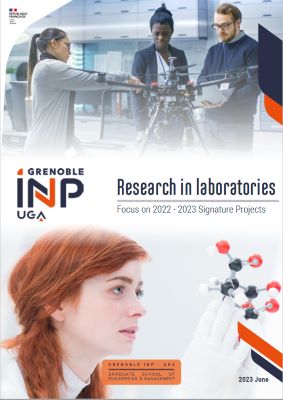While traditional computing relies on data that is coded using bits (a state of 0 or 1), quantum computing is built on quantum bits, or “qBits”, which can simultaneously take on the value 0, 1 or any infinite number of states between 0 and 1. This change completely revolutionizes computing.
The scientific community in Grenoble is ready to launch this revolution both in terms of research and education. The various skill sets necessary for this field are coordinated by the Quantum Engineering CDP that was launched three years ago and is funded by Idex (QuEnG). In terms of hardware, qBits are being developed at Leti (CEA), IRIG (CEA/UGA) and Institut Néel (CNRS). “Grenoble has a history of expertise on the subject of qBits and the various materials used for quantum computing. There are various types of qBits: spin (electrons, molecular instances), photonics (polarization of unique photons), or supraconducteurs. Grenoble is also a leading proponent of the spin qBit composed of an electron in silicon, which is compatible with CMOS manufacturing,” explains Alexia Auffèves, CNRS research director at Institut Néel and coordinator of the CDP.
From hardware to software
Mehdi Mhalla, CNRS research at LIG (CNRS/Grenoble INP/Inria/UGA), is working on the software side of things for the CDP. He studies how quantum computing will change our use of data. If we demonstrate the ability for a quantum computer to perform all actions carried out by a normal computer, the the superposition** phenomena will accelerate the speed of calculations. “It’s possible to carry out very complicated calculations with much fewer steps than required by a classical computer. If you need n steps with a classical computer to solve a search problem in a database, then you need √n to solve the problem quantically,” explains Mehdi Mhalla. Quantum solutions could be particularly useful for extremely complex problems in which the enormous amount of data required is too much for even a classical supercomputer to handle. “For example, the algorithm discovered by Shor in 1994 could factorize a whole number into two prime numbers at record speeds. This would make it possible to hack security keys used for bank transactions,” adds the researcher, who also teaches quantum cryptography to students in the Grenoble INP-Ensimag and UFR IM2AG Cybersecurity master’s degree.
The concept of quantum entanglement** offers even more surprising possibilities for quantum communications. “The ability to ‘entangle’ qBits, in other words turn them into a single quantum system, will enable secret information to be shared in a trustworthy manner thanks to protocols that don’t exist in classical computing.”
Forteza’s report also reminds us that the development of quantum technology will require changes in education for future quantum engineers. The CDP has positioned itself on the cutting-edge of this change by inspiring and supporting a project based on inverted education methods. This new educational project offers small, multidisciplinary groups of students, physicists and computer engineers to access and code quantum algorithms on IBM’s processor (IBM is the sponsor of Grenoble INP-Ensimag’s latest graduating class). Such educational experiences are the first steps towards true multidisciplinary programs that will draw on the full potential of the Grenoble ecosystem. Traditional industry partners such as STMicroelectronics, SOITEC and ATOS are also closely monitoring all advances made in the field of quantum computing.
*Cross Disciplinary Program
** An introduction to quantum physics to facilitate understanding
The first quantum computing theories were developed in the 80s and relied on the surprising characteristics of quantum physics. When dealing with the infinitely small, matter no longer follows the rules we usually apply. According to the mechanics of the infinitely small, an object can be in several states at once and is in an undetermined state until it is measured. As a result, an electron can be in different places and move at various speeds at the same time. Or a photon can simultaneously have two types of polarizations. This is known as the superposition theorem.
Another important concept is that of quantum entanglement. This principle explains that two quantum objects that are apparently independent can be forced to link. For example, they can be forced to be in opposite states at the time of measurement. If no information is exchanged between the two particles, they are linked not as two seperate, independent systems, but as simply one system. Therefore, in quantum physics, we can link several systems that appear to be independent and far away from each other. As a quantum state can always be extended at microscopic levels, we can play with all of these possibilities using simple, cold, isolated atoms.




